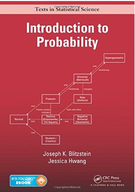Use Poisson approximations to investigate the following types of coincidences. The usual
Chapter 4, Problem 66(choose chapter or problem)
Use Poisson approximations to investigate the following types of coincidences. The usual assumptions of the birthday problem apply, such as that there are 365 days in a year, with all days equally likely. (a) How many people are needed to have a 50% chance that at least one of them has the same birthday as you? (b) How many people are needed to have a 50% chance that there are two people who not only were born on the same day, but also were born at the same hour (e.g., two people born between 2 pm and 3 pm are considered to have been born at the same hour). (c) Considering that only 1/24 of pairs of people born on the same day were born at the same hour, why isnt the answer to (b) approximately 24 23? Explain this intuitively, and give a simple approximation for the factor by which the number of people needed to obtain probability p of a birthday match needs to be scaled up to obtain probability p of a birthday-birthhour match. (d) With 100 people, there is a 64% chance that there are 3 with the same birthday (according to R, using pbirthday(100,classes=365,coincident=3) to compute it). Provide two dierent Poisson approximations for this value, one based on creating an indicator r.v. for each triplet of people, and the other based on creating an indicator r.v. for each day of the year. Which is more accurate?
Unfortunately, we don't have that question answered yet. But you can get it answered in just 5 hours by Logging in or Becoming a subscriber.
Becoming a subscriber
Or look for another answer
